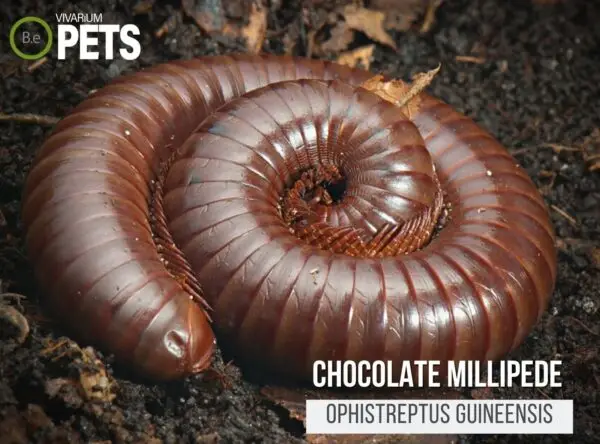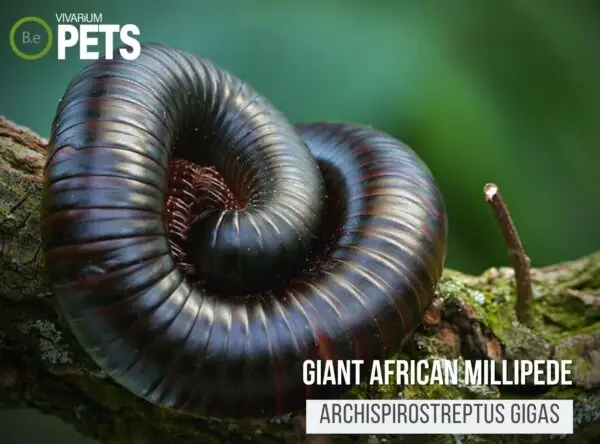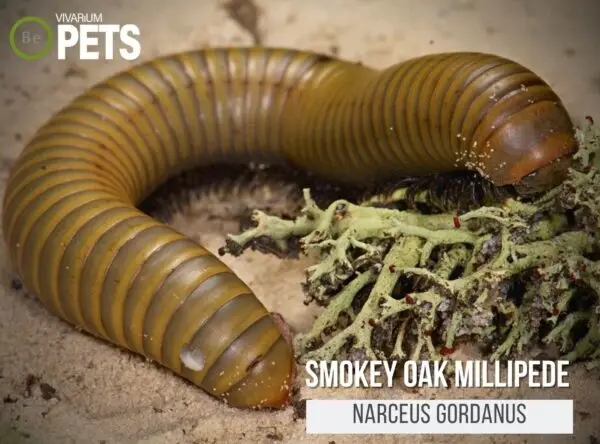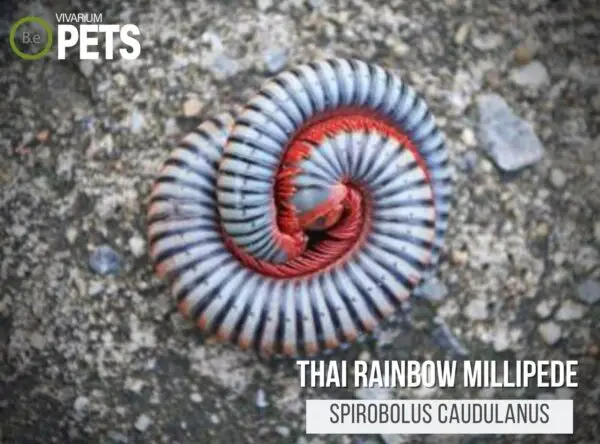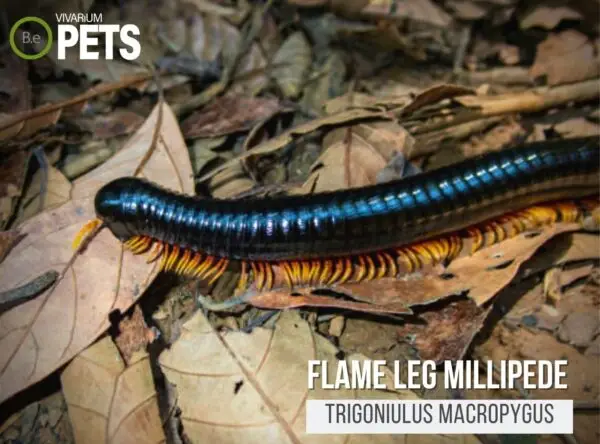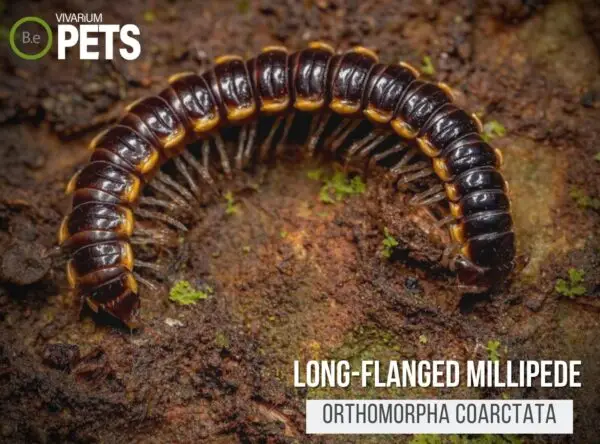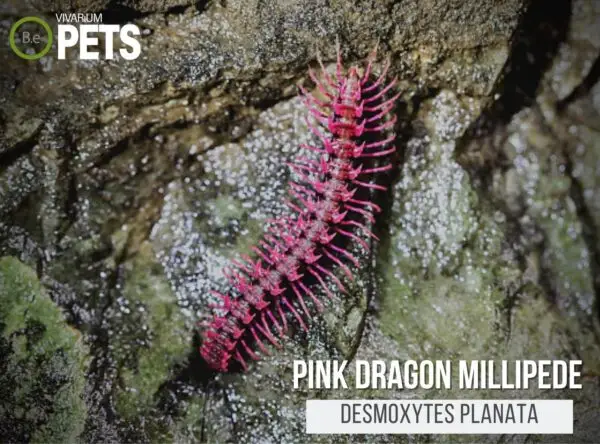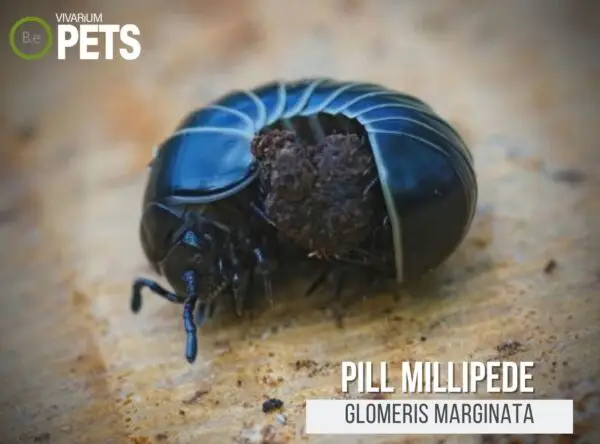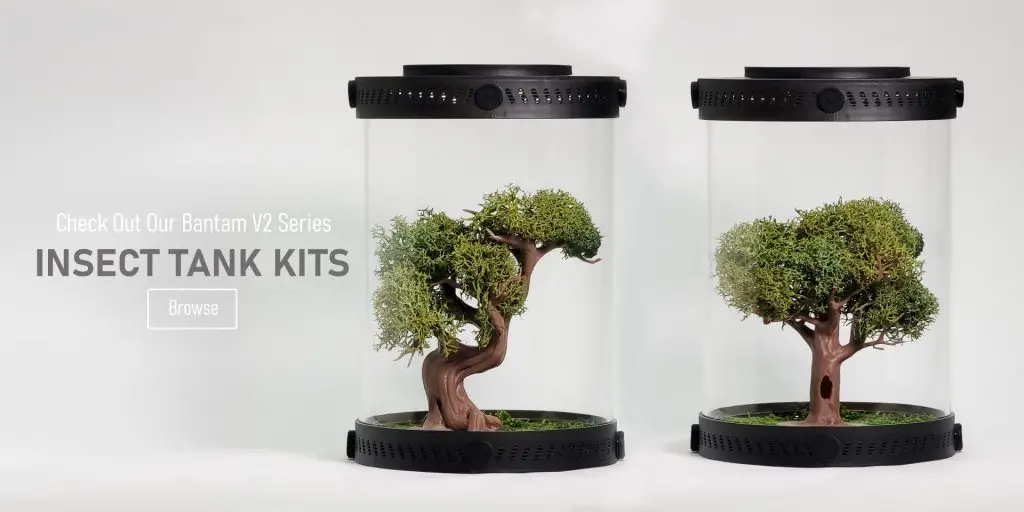When it comes to keeping a small exotic pet, millipedes can make a great addition!
Pet millipedes are fascinating creatures that offer a variety of benefits to terrariums.
However, it’s important to understand their needs, natural environment, and care routine to ensure they are healthy and safe.
In this article, we will explore the growing popularity of millipedes as pets, housing, different species, and nutrition.
We will also cover substrate setup, and maintenance requirements to help you create a beneficial and happy environment for your many-legged companions.
Table Of Contents:
ToggleBest Pet Millipedes For Terrariums
Terrariums provide a great habitat for pet millipedes, and there are many types of millipedes to choose from.
Generally, millipedes can be divided into two categories – small and large.
Small millipedes are typically anything under three inches in size, while large millipedes can be up to a foot or more in length.
Some of the most popular giant pet millipedes include species native to Africa, America as well as Asia.
Many of the more common small millipedes are found throughout America, Asia, and Europe.
Thanks to international trade and the help of the internet, owning many of these types of millipedes is made possible no matter where you’re located!
Each species has its unique characteristics and care requirements, so it’s important to research the different species to choose the best pet millipede for your terrarium.
Create the perfect home for your millipedes with our Customizable Millipede Terrarium Kits, designed to meet all their habitat needs.
Giant Millipedes
Giant millipedes are some of the most popular and sought–after types of pet millipedes.
Some of these impressive creatures can reach pretty remarkable lengths, like Archispirostreptus gigas which grows to be about 13 inches long.
These millipedes are often colorful and come in varieties such as Giant Fire millipedes and Thai Rainbow millipedes, so you can find a species that will complement your terrarium’s aesthetic.
Giant millipedes require a large terrarium to ensure that they have enough space to move around.
They appreciate environments with plenty of hiding places, such as under decoration, rocks, and wood, as well as plenty of substrate for burrowing.
They also feed on decomposing plant material, making them an ideal choice for enclosures with a lot of live terrarium plants.
Giant African Millipedes
Giant African Millipedes are probably the most well–known giant pet millipede species.
They are native to Africa and the smallest species is known to grow to at least 6.5 inches long.
They prefer high-humidity climates and a stable temperature range of 70–80°F.
Because of their size, it’s recommended to house these African millipedes in larger terrariums with an appropriate substrate and moist hide area.
They are nocturnal and prefer to spend the day in moist burrows or hiding spaces to stay hydrated.
In terms of nutrition, African millipedes should be fed a variety of fruits and vegetables, as well as regular calcium supplementation.
Click on one of the images below to see the millipede’s specific care requirements:
Giant American Millipedes
Giant American millipedes are very popular pet millipedes due to their impressive size and accessibility within the US.
They are typically various shades of brown with stripes running horizontally along their body.
Although these millipedes are native to the eastern and southeastern regions of the United States, they can be found in warmer, tropical climates around the world.
Giant American millipedes are considered fairly low-maintenance pets and can, with the right care, live up to 10 years, making them wonderful inhabitants of terrariums.
Click on one of the images below to see the millipede’s specific care requirements:
Giant Asian Millipedes
Giant Asian Millipedes are thought to be the creme of the crop by many hobbyists due to their exotic colors paired with their size.
Some of these large millipedes typically grow up to 12” long, and can be found in an array of colors including blue, pink, and gold.
These shy and docile insects are primarily nocturnal and social, so they do best when housed in groups of two or more.
They enjoy humid environments with plenty of tan-bark or peat moss substrate and easy access to various hiding places.
They are strict vegetarians who feed on decaying plant material such as leaves, mulch, and mushrooms, making them great inhabitants of any terrarium.
Click on one of the images below to see the millipede’s specific care requirements:
Small Millipedes
Small millipedes, as the name implies, are usually less than three inches long.
Generally speaking, they are less active, making them better suited for smaller terrariums.
Many of these species also have shorter lifespans than their larger counterparts but are typically much easier to breed.
Small millipedes do well in moist environments, so they should be maintained in terrariums that have the proper humidity and temperature.
They feed on organic matter, so they should be provided with plenty of decomposing leaves and other organic matter.
Small American Millipedes
The most commonly kept small American species of millipedes are typically found in the Eastern U.S.
These pet millipedes are very hardy and make a good choice for beginner hobbyists.
They are easy to feed and are quite active, making for great viewing in a terrarium.
Because of their hardy nature, small American millipedes can withstand a wide range of temperatures and moisture.
However, too much humidity can lead to trouble, so it’s important to regulate the environment accordingly.
Click on one of the images below to see the millipede’s specific care requirements:
Small Asian Millipedes
Small Asian millipedes make popular pet millipedes thanks to their unique variety of shapes and sizes.
These millipedes vary in size from one to two inches and have bright and vibrant colors including yellow, orange, and pink!
They do well in both indoor and outdoor vivariums and need a substrate that allows for both burrowing and climbing.
These pet millipedes should be provided with lots of hiding places and areas of high humidity, as well as fresh fruits and vegetables to eat.
Small Asian millipedes live an average of three to five years, making them an excellent choice for millipedes as pets.
Click on one of the images below to see the millipede’s specific care requirements:
Small European Millipedes
What small European millipedes lack in size they make up for in distinctiveness!
They are some of the most popular species to keep in terrariums due to their small size, hardy nature, and availability.
These pet millipedes only reach lengths of up to 2.5 inches, making them the perfect size for terrariums where space is limited.
They are also very resilient, and able to withstand a wide range of temperatures and humidity.
Click on one of the images below to see the millipede’s specific care requirements:
Best Type Of Millipede Terrariums
When choosing the best type of millipede terrarium, many factors need to be taken into account.
For example, you must consider the natural environment of the millipede, its size, and the temperature and humidity preferences of the species you are keeping.
You should also consider the size of the tank that best suits the species you would like to keep.
For small-bodied millipedes, a 5-10 gallon tank is sufficient. For larger species, a 20-30 gallon tank will be needed.
All terrariums should have screened lids to help maintain proper air circulation and some should also be outfitted with lights.
A terrarium lighting on a scheduled day/night cycle is ideal for replicating the natural environment of these creatures.
Best Millipede Substrate
When it comes to the millipede substrate, a 5-10cm depth of peat moss, vermicompost, and coco fiber is recommended.
Also, various pieces of wood, cork bark, and rocks should be added to create a natural and interesting environment for your pet millipedes.
Our Bioactive Millipede Substrate Blend is specially formulated to meet the needs of various millipede species, providing an optimal balance of moisture and nutrients.
Best Plants For Millipedes
Many pet millipedes need a humid environment that must be provided for them to thrive.
Providing plants in their terrariums is a great way to supply moisture and create a more natural habitat for your millipedes as pets.
Some popular plants that are ideal for millipede terrariums are low-light terrarium plants as well as tropical terrarium plants.
These plants are all low–maintenance, easily available, and safe for your pet.
When selecting plants for your millipedes, it‘s important to make sure they are pesticide and fertilizer–free to keep your pet safe and healthy.
Proper Pet Millipede Care
Caring for your pet millipede requires providing a suitable habitat with the right temperature and humidity.
You should also be offering the appropriate food, monitoring the terrarium, and creating a suitable substrate.
It is good practice to provide enrichment items, observe for signs of distress or health issues, and quarantine new millipedes.
Furthermore, maintaining a clean terrarium is essential to keep a healthy microhabitat. Following these steps will keep your pet millipedes happy and healthy.
Moisture & Humidity
Millipedes are sensitive creatures and require the right conditions to thrive.
Monitoring and adjusting moisture and humidity accordingly is key to creating a suitable habitat.
Keep the substrate slightly damp and maintain the humidity between 50–80%, as too much moisture can result in illness or death.
And make sure to monitor if the terrarium gets too dry, as this can also be detrimental to the health of many millipede species.
By making the necessary adjustments and monitoring the conditions, your pet millipedes will be able to enjoy a safe and healthy habitat.
Feeding & Supplementation
Millipedes require adequate nutrition for a healthy and long life. The diet may vary depending on the species.
Generally, they enjoy plant matter such as leafy greens, vegetables, and fruits.
Additionally, small amounts of animal–based proteins like mealworms can provide supplementation.
To ensure optimal health for your millipedes, provide a balanced and varied diet with occasional treats.
Click the image below to learn more about my DIY millipede food recipe and best choices.
Identify & Treat Stress
To identify and treat common problems in pet millipedes, it is important to monitor the terrarium regularly and look for signs of distress or health issues.
This could include discoloration, spots, or an abnormal amount of molting.
If you notice any of these issues, it is important to take action quickly and consult with a veterinarian if necessary.
How To Culture Millipedes
This guide provides a comprehensive overview of how to cultivate millipedes in a terrarium.
We will discuss the necessary materials, setup requirements, and the basic maintenance needs of millipedes.
By following this guide, you will have all the tools to create a successful and healthy habitat for your pet millipedes.


Materials:
Steps to a successful millipede culture
Conclusion
Creating an appropriate habitat for pet millipedes takes effort and dedication, but the rewards are worthwhile.
Whether you’re a newbie or already have experience with keeping millipedes as pets in terrariums, following the information provided in this article will help you create a happy and healthy environment for your new companions.
Understanding the different species, housing requirements, diet, and maintenance is essential for their well–being, so make sure you do your homework before getting started.
Create the ideal habitat for your millipedes with our species-specific soil mixes and Insect Enclosure Kits. These products provide everything you need for a successful and thriving millipede colony.
Frequently Asked Questions
Pet millipedes can live for two to ten years, depending on the species and care provided, and some may live longer if well-cared for with suitable habitat, nutrition, temperature, and humidity.
No, millipedes are not illegal in the US.
However, certain species of millipedes may be regulated or restricted in some states due to their potential impact on agriculture or the environment.
Some species of millipedes are detritivores, feeding primarily on decaying organic matter, while others may supplement their diet with live or fresh plant matter.
It’s important to research the specific dietary requirements of the species of millipede you are keeping to ensure their nutritional needs are met.
The “best” pet millipede may vary depending on personal preferences and experience level. Popular species for beginner millipede keepers include the Giant African Millipede, the Bumblebee Millipede, and the Ivory Millipede, as they are generally docile and easy to care for.
Handling millipedes is generally not recommended due to their potential to release a defensive chemical that may irritate the skin and eyes of humans.
If necessary, precautions such as wearing gloves and gently coaxing the millipede onto a soft-bristled brush or a clean plastic container can be taken to prevent injury and avoid the release of the defensive chemical, followed by thorough hand washing to remove any potential bacteria or parasites.
Millipedes curl up when they are touched as a defensive mechanism to protect themselves from predators. This helps to protect their soft undersides and presents a more difficult target for predators to attack.
Millipedes do not have venom and are not considered dangerous to humans.
However, some species may secrete a defensive chemical that can cause skin irritation or allergic reactions in some people.
It is difficult to accurately determine the age of a millipede, as they do not have distinct growth rings or other reliable markers of age.
However, in general, millipedes tend to live for several years and will continue to grow and molt throughout their lifespan.
Yes, millipedes play an important role in the ecosystem as detritivores, breaking down and recycling decaying organic matter.
They help to return nutrients to the soil, which can benefit plant growth and support the food chain.
Additionally, millipedes serve as a food source for many predators, including birds, reptiles, and other invertebrates.
Millipedes can release a defensive fluid that can be irritating to human skin and some species can cause damage to crops and gardens.
The number of millipedes that can be kept together depends on the size of the enclosure and the species of millipede, but generally, it is recommended to keep no more than 10-15 individuals per enclosure.
Millipedes do not undergo a metamorphosis process, meaning they do not turn into something else.
They hatch from eggs as small versions of adults and then grow through a series of molts until they reach their full size.
Millipedes do not require a companion to thrive, as they are generally solitary creatures and can live alone in their enclosures.
However, some species may tolerate the presence of others, as long as there is enough space and resources available.
To care for a pet millipede, provide them with a secure, humid, and temperature-controlled environment with plenty of places to hide and a varied diet of fruits, vegetables, decaying organic matter, and leafy greens.
Millipedes can survive indoors if their environmental needs are met, such as appropriate substrate, humidity, temperature, and food.
However, they may not thrive without proper care and can become a nuisance if they escape their enclosure.
Millipedes do not bite or sting in a defensive manner.
Millipedes are generally not poisonous to dogs, but some species may release a defensive fluid that can cause irritation or mild toxicity if ingested.
If you suspect your dog has ingested a millipede, it is best to monitor them closely and contact your veterinarian if any symptoms develop.
Millipedes can emit a defensive fluid that has a pungent, unpleasant odor.
The smell has been described as similar to almonds, vinegar, or rotten cherries.
Millipedes can be beneficial for terrariums as they help to decompose organic matter and can enhance soil health. They can also make for very interesting pets.
It is generally not recommended to put a millipede in a fully closed terrarium as they require adequate ventilation to prevent the buildup of harmful gases and maintain proper humidity levels.
Instead, it is best to provide a partially open or well-ventilated enclosure.
The minimum tank size for millipedes depends on the species and the number of individuals being housed, but as a general guideline, a tank size of at least 10 gallons can be suitable for smaller species and a larger tank may be needed for larger or more active species.
Millipedes are generally considered low-maintenance pets as they do not require a lot of attention or interaction.
However, they do have specific environmental needs such as humidity, temperature, and substrate, which must be properly maintained to ensure their health and wellbeing.
There could be several reasons why millipedes are dying, including incorrect environmental conditions such as temperature, humidity, substrate, lack of ventilation, inadequate or inappropriate food, exposure to harmful substances or predators, or disease.
It is important to identify and address the underlying issue promptly to prevent further deaths.
Millipedes can eat mold, as well as decaying plant matter and other organic materials.
However, it is important to ensure that the mold is not caused by harmful bacteria or toxins and that the millipedes are provided with a varied and nutritious diet to maintain their health.
Millipedes do not require water dishes, as they obtain moisture from their food and the humidity in their environment.
However, it is important to maintain proper humidity levels in their enclosure, which can be achieved through misting the substrate or providing a damp substrate, to ensure they have access to sufficient moisture.
Millipedes and isopods (also known as pill bugs or sow bugs) can coexist peacefully in the same enclosure, as they have similar environmental requirements and are both detritivores that feed on decaying plant matter.
However, it is important to ensure that there is enough space and resources for both species and to monitor their behavior to prevent any aggressive interactions.
Yes, millipedes can get mites, which are small parasitic arthropods that can attach themselves to the millipede’s exoskeleton or burrow into its body.
Mites can cause irritation, discomfort, and stress to the millipede and may also transmit diseases or pathogens.
Regular cleaning and maintenance of the millipede’s enclosure can help prevent mite infestations.
Millipedes do not require UVB lighting as they are primarily nocturnal and do not rely on UVB to produce vitamin D or maintain other physiological functions.
However, they do require a suitable light cycle and may benefit from some low-level ambient lighting during the day to promote natural behaviors and maintain a regular day-night cycle.
Millipedes can coexist with plants in their enclosure, but it is important to choose non-toxic plants that do not require high levels of humidity or moisture, and that is compatible with the millipedes’ behavior and needs.




